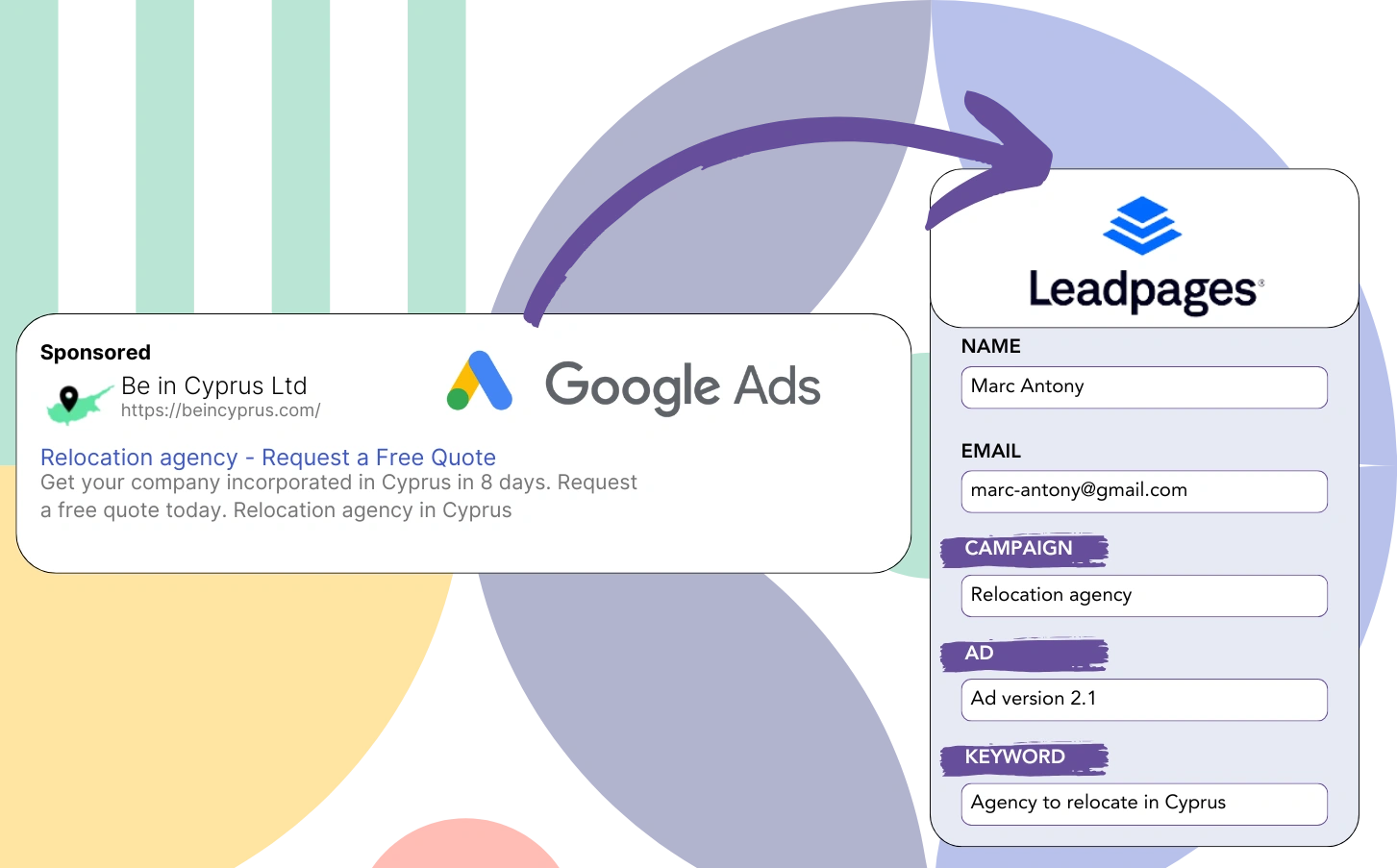You rely on Google Ads for leads, but you can’t identify which campaigns are bringing you customers.
This is a familiar problem. Google Ads provides the number of leads from campaigns, ads, or keywords but does not include individual lead data.
Hence, you cannot ascertain which campaign, ad, or keyword was responsible for generating leads that turned into customers.
LeadSources fixes this issue.
LeadSources provides the ability to track your Google Ads data (campaign, ad, keyword, etc.) per lead.
Google Ads data (campaign, ad, keyword, etc.) can then be stored for each lead in Leadpages.
You can then compile reports like “Keywords that generated the most leads” and decide on promoting or canceling specific keywords.
Let’s dive in!
Capture Google Ads lead data in Leadpages in 4 steps
Step 1: Add Leadsources in the head tag of your website
Sign up to Leadsources.io, and benefit from our 14-day free trial.
Insert the LeadSources code into the head tag of your website. No coding skills are required.
Simply follow this easy step-by-step guide.
Step 2: Add the UTM parameters to your Google Ads campaigns
Implement the UTM parameters you want to monitor in all of your Google Ads campaigns.
Some examples of UTM parameters to include in your ad are:
- UTM_source
- UTM_campaign
- UTM_term
- UTM_content
LeadSources also records information not covered by UTM parameters, including the channel, landing page, and subfolder, for a full lead-level picture.
Step 3: Add the hidden fields in Leadpages
When users fill out your Leadpages (name, email, etc.), LeadSources automatically populates the hidden fields with information from Google Ads (campaign, ad, keyword, landing page, etc.).
To implement this, follow the instructions in this guide to add hidden fields in Leadpages.
LeadSources will automatically place the Google Ads data into your Leadpages.
Step 4: Capture the Google Ads data in Leadpages
When your Google Ads ad is clicked and the visitor reaches your page, LeadSources collects the Google Ads data (campaign, ad, keyword, landing page, etc.).
LeadSources automatically populates the hidden fields in your Leadpages with Google Ads data.
Upon form submission, the Google Ads data along with the responses is directed to the submissions page in Leadpages.
How does Leadsources work?
When you insert the LeadSources code into the head tag of your website, it will gather Google Ads data (UTM parameters and referrer) on every visit to your site.
The hidden fields of your Leadpages are then updated with the Google Ads data.
If there are no UTM parameters in the URL, LeadSources will still obtain data about the visitor through the referrer:
- Channel
- Source
- Campaign
- Landing page
- Landing page subfolder
This process enables you to keep track of important lead source details even if UTM parameters are not applied, including:
- On Google Search
- On your Instagram bio link
- On your social media posts
- Etc.
Many tools track lead information only when UTM parameters are applied (mostly on paid and referral channels) – this is an issue!
LeadSources gathers lead data from every channel, even in the absence of UTM parameters:
- Organic Search
- Paid Search
- Organic Social
- Paid Social
- Referral
- Affiliate
- Display Advertising
- Direct Traffic
This provides a way to consolidate and monitor all lead source data in a single central location.
Pro tip:
Track Google Ads data in all the popular online form builders, including Cognito Forms, Gravity Forms, Jotform, Typeform, WPForms, and more. Learn how to add Google Ads UTM parameters in any form builder.
How to run performance reports
Now that Leadpages holds your Google Ads data, you can create performance reports such as:
- Leads per campaign
- Leads per ad
- Leads per keyword
- Etc.
This helps you determine the best way to allocate your Google Ads budget.
Let’s go over the different reports you can generate.
Lead performance reports
You have the ability to generate reports that indicate the volume of leads from:
- Channel
- Campaign
- Ad
- Keyword
- Landing page
- Landing page subfolder
Example #1
You can create a report titled “Leads by Channel” by exporting the data from campaigns across different channels (SEO, PPC, email, etc.).
Example #2
After finding the channel that yields the most leads (e.g., Google Ads), you can narrow down by choosing this channel to view the lead count for each individual ad campaign.
Example #3
Once you know which campaign is generating the most leads, you can examine which particular keywords are creating these leads.
Sales performance report
It’s helpful to know which ads and keywords produce the most leads, but do they also result in more revenue?
Uploading your Leadpages submissions to a CRM enables you to build detailed sales reports.
Example:
| Channels | Search Paid | Social Paid |
| Leads | 50 | 75 |
| Sales | 5 | 6 |
| Average order value | $150 | $100 |
| Revenue | $750 | $600 |
From your Google and Facebook ad campaigns, you found that Social Paid ads yielded a larger number of leads than Search Paid ads.
Analysis over several weeks indicates that the Search Paid channel achieved greater revenue with fewer leads compared to the Social Paid channel. This leading in raising the budget for Search Paid campaigns.
LeadSources tracks the source of each lead in Leadpages, whether they come from ads, organic search, social, email, etc. and syncs that data with each submission. See the full breakdown on the lead source in Leadpages page.
